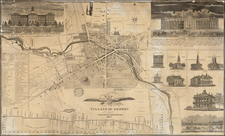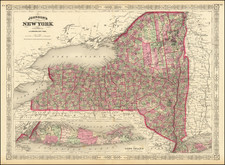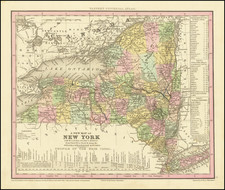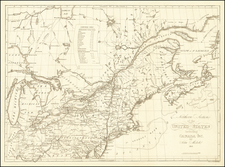Rare View of the (now lost) Great Cohoe Falls
Rare engraved image of the Cohoe Falls on the Mohawk River, published in New York by R.H. Laurie.
The image is the final (and extremely rare) re-issue of one of a series of mezzotint views which was issued collectively issued as Scenographia Americana in 1768. Originally dran drawn by Colonial Governor Thomas Pownall on one of his trips while governor of Pennsylvania and New York, probably about 1759. The Cohoes Falls on the Mohawk, now submerged beneath the water behind a dam, was a famous natural phenomenon in America, on the edge of what was then wilderness and before the more spectacular Niagara was reachable by anyone but fur traders. Pownall's view, taken from downstream looking up at the falls, captures the untamed wildness of the scene in a dramatic way.
The present view, re-issued by Robert Holmes Laurie in 1827, omits about 1 inch of the image on the left write and bottom portions of the image, but is otherwise very faithful to the original, which was based upon a painting by Paul Sandys from Pownall's original painting.
This RH Laurie issue is extremely rare. The original title, A View of the Great Cohoes Falls, on the Mohawk River . . . has been modified.
Rarity
We find only a single catalog entry for the map in a 1928 Maggs Brothers Catalog, Item #84, priced at 10 shillings, 6d.
Richard Holmes Laurie (1777-1858) was the son of mezzotint engraver Robert Laurie, who had taken over Robert Sayer's publishing house with James Whittle in 1794. Richard Holmes Laurie joined in a partnership with Whittle when his father retired in 1812. The name of the firm then switched from Laurie & Whittle to Whittle & Laurie. Whittle died in 1818, leaving Richard Holmes to continue publishing alone as R. H. Laurie.
When the Hydrographic Office opened in 1795, it was tasked with creating and producing all the nautical charts for the Royal Navy so as to wean the Navy off dependence on foreign charts. By the 1820s, private publishers were augmenting HO charts and competing with them, including Richard Holmes Laurie. Richard gave up publishing anything except nautical materials by 1830. He also sold charts to Trinity House, the lighthouse and maritime safety fraternity. He died in 1858.
The firm continued to print under the name R.H. Laurie even after 1858. Later, the firm was managed by Laurie’s draughtsman, Alexander George Findlay, and, later, Daniel and William Kettle.












![(Ecclesiastical Districts of the American Northeast) Tav. CXXVIII Provincia ecclesiastica di Nuova York [e di Boston]](https://storage.googleapis.com/raremaps/img/small/89777.jpg)

![[ Inhabitants of New Netherlands ] Einwohner in Neu Niederland](https://storage.googleapis.com/raremaps/img/small/94087.jpg)